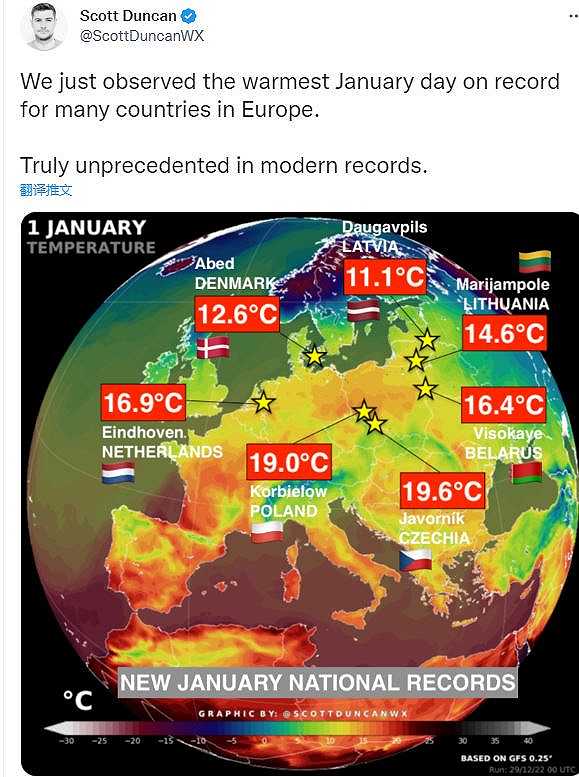After the snowstorms in the United States and Canada, Europe ushered in a historic warm winter at the end of last year. On January 1 this year, the temperature in at least seven European countries broke the historical record, and the high temperature in France and Spain was nearly 25℃.
The unusually high temperature in winter temporarily eased the energy crisis in Europe, and the benchmark price of natural gas fell to the lowest level since the Russian-Ukrainian conflict. However, high temperature also makes ski resorts scarce due to insufficient snowfall, and at the same time increases the risk of drought in spring and summer in Europe.

According to a report by the British Reuters on January 4th, on December 30th and 31st last year, the night temperature in France broke records continuously. On January 1st this year, the highest temperature in southwest France reached 24.9℃.
On New Year’s Day, the temperatures in Denmark, the Netherlands, Poland, the Czech Republic, Lithuania, Latvia and Belarus all broke historical records, and the temperatures in Poland and the Czech Republic rose above 19℃. Czech media reported that due to the warm winter, some plants began to blossom ahead of schedule.
Since January, the high temperature of 20℃ has appeared in parts of Germany and Switzerland, and reached 25.1℃ in the Basque country in northern Spain. From December 31st last year to January 2nd this year, hundreds of monitoring points in Germany alone reported new high temperature records. The Swiss meteorological department even issued a pollen warning in advance to remind allergic people to protect in advance.
So far, only Ireland, Italy, Norway, Britain and parts of the southeastern Mediterranean have not broken the historical record, and Greece has reported a high temperature of 20℃. Meteorologists call this year’s warm winter in Europe the “most extreme” situation in European climatology.
French meteorologists pointed out that the country’s winter high temperature reached its peak from December 30 last year to January 2 this year, but this abnormal weather has lasted for two weeks and will continue afterwards. Greek meteorologists predict that this round of abnormal weather will last for more than 30 days.
As to why the unusually high temperature occurred in Europe this winter, scott Duncan, a British meteorologist, said that it is difficult to determine the specific reasons at present. He said that La Nina phenomenon and unusually warm sea surface are one of the reasons, but these two phenomena did not appear this year. Climate warming and ocean warming are the ultimate causes of extreme weather.
For Europe, which is caught in the energy crisis, a warm winter can make countries breathe a sigh of relief.
Due to the decrease in heating demand, the price of natural gas has also decreased. By Wednesday morning local time, the benchmark price of natural gas in Europe had dropped to 70.25 euros per megawatt hour, the lowest level since February 2022.
The Italian Energy Agency predicts that if the warm winter continues, the country’s energy prices will fall overall this month. British consultants predict that energy prices in Britain will fall this summer after the warm winter.
Although it helps to reduce heating demand, warm winters also lead to insufficient snow in European mountainous areas.
Adelboden, a Swiss ski resort that will host the Ski World Cup this week, announced that almost all competitions this year can only be held on artificial snow due to high temperature and insufficient snowfall. At present, the local temperature at an altitude of 2000 meters is also above 0℃.
In France, snow resorts above 2000 meters above sea level can still operate normally, but snow resorts at lower altitudes can only be forced to close. In Switzerland, some snow resorts without snow were forced to change their business strategies and open summer hiking routes to tourists.
In addition to the impact on the ski industry, the reduction of snow and the accelerated melting of glaciers caused by warm winters may also lead to droughts in spring and summer in Europe, affecting hydropower generation and cooling of nuclear power plants.
Europe suffered from drought last spring, and there was a double attack of drought and high temperature in summer. Temperatures in many countries have broken records, and the historical high temperature of 40 C appeared in Britain for the first time in July. Last year’s drought and high temperature caused the water volume of many major rivers in Europe to drop sharply, which severely damaged hydropower, nuclear power generation and coal transportation.
Hydroelectric power is the second largest renewable energy source in the EU. In 2020, 33% of renewable